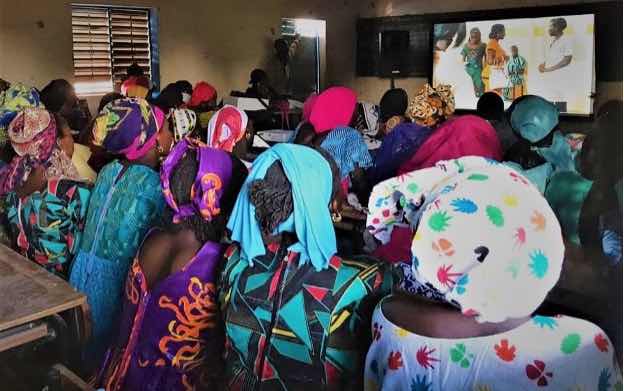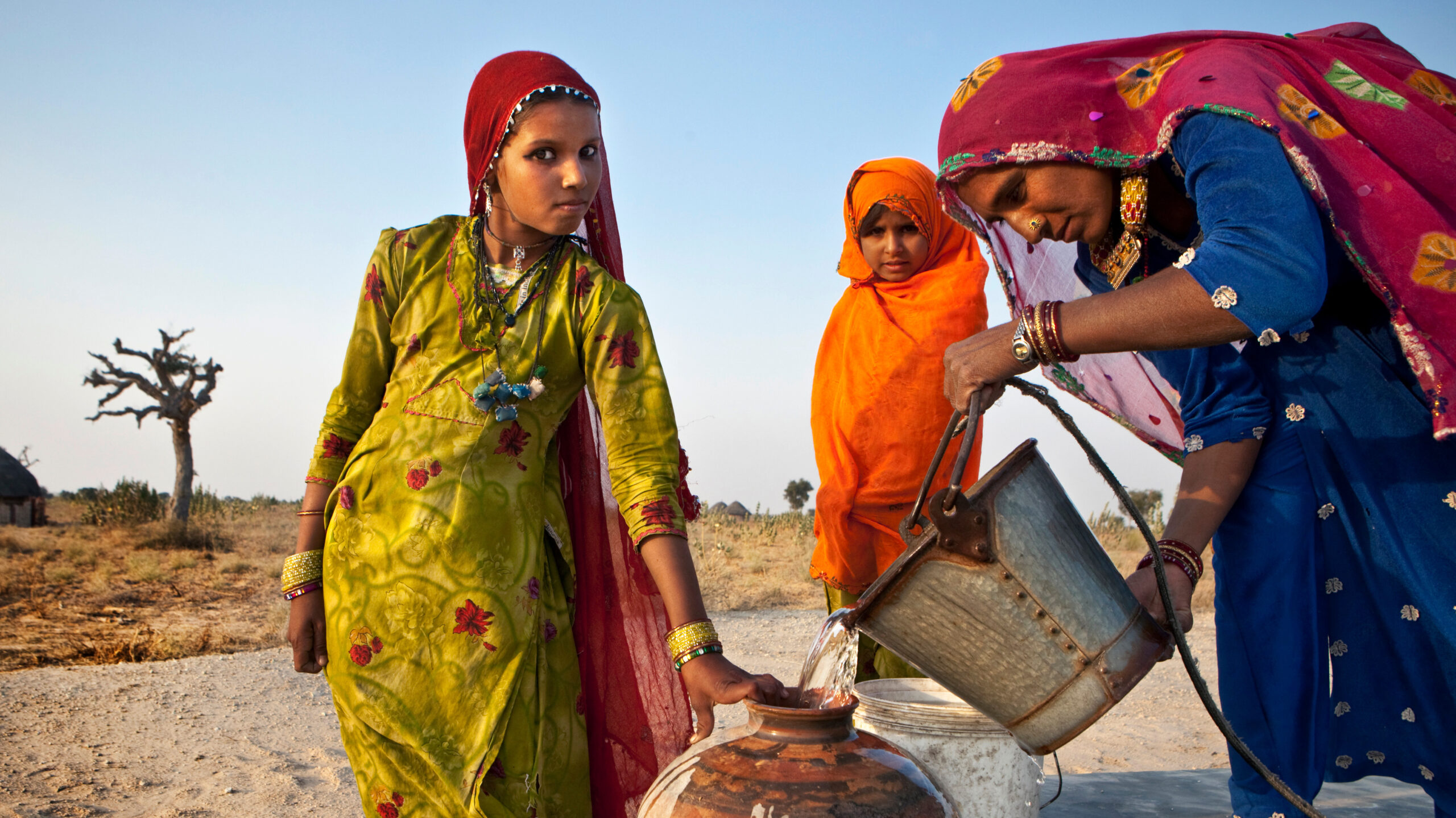Translation option:
“We would never have imagined that this would happen within our walls. It’s a nice surprise for us so […] Previously, who would have thought that cinema could reach this far? Nobody! The cinema we only heard about in urban areas.” ~ Village chief
Edutainment (shorthand for education + entertainment) delivered through television, radio, and other mass media platforms is a rapidly growing social and behavior change strategy that employs persuasive and emotionally captivating narratives on specific topics to reach broad populations. The appeal of edutainment comes in part from its scalability: Television and radio can reach millions, potentially at a fraction of the cost of traditional community-based programming.
While there is a growing body of research on the impact of edutainment interventions, there is limited evidence on how such interventions can be effectively implemented, especially in rural areas with limited access to electricity and technological advances, such as television and smart phones. To address these questions, we conducted a process evaluation of the television edutainment series C’est la Vie!, to document the challenges of implementation in rural, conservative areas of Senegal. C’est la Vie! revolves around everyday life in a maternal health clinic and is produced by Dakar-based Réseau Africain d’Education en Santé (RAES, African Network of Health Education). Through its dramatic storylines, it aims to educate and entertain its audience about diverse themes, including sexual and reproductive health, maternal and child health and gender-based violence.
In our study, C’est la Vie! was implemented by the NGO, MobiCiné, through biweekly “mobile film clubs” targeted to adolescent girls and young women in rural Senegal. Complementary activities included post-screening discussions and thematic workshops run by trained female facilitators, meant to reinforce the messages in the series and catalyze changes in social norms. Using qualitative methods, including structured observations, individual interviews, and focus groups, the process evaluation specifically assessed implementation outcomes (intervention adaptations and fidelity), as well as participants’ responsiveness or engagement, and series appropriateness for the target population.
Here are the process evaluation’s key takeaway messages for future implementation of edutainment in rural, conservative areas:
1. Adaptations to ensure “fit for purpose”: Community-based interventions must often be adapted to fit local needs and conditions—sometimes in advance though “pro-active adaptations,”—but also during implementation through ad hoc or “reactive” adaptations. Such adaptations are rarely documented, and our study offered an important window on this process. Prior to the start of the C’est la Vie! study, a pilot in six villages helped determine the best location, time, and length of the film clubs. The post-screening discussions and workshops were also adapted to be lighter in content and time, in order to improve feasibility of implementation and to make it easier for women and girls to participate given their existing time constraints. During the implementation period, adaptations were also made to help increase attendance. For example, facilitators asked community health volunteers, village chiefs, or children returning home from school to advertise dates and provide reminders for screenings. Facilitators also organized horse-drawn carts to transport participants to film club locations. Although C’est la Vie! was dubbed into local languages, content for thematic workshops was not, thus facilitators simultaneously translated tools—including interactive games—from French into local languages. These examples highlight the types of adaptations and flexibility required to ensure the intervention was fit for purpose in rural areas.
2. Implementation fidelity: A key element in evaluating an intervention’s success is understanding if delivery is executed as intended—including reaching the target population, quality of implementation, and adherence to the original design. Our study targeted adolescent girls and young women (aged 14 to 34); attendance was high with nearly 90% of the target group attending at least one screening and 30% attending all six screenings. Evidence from in-depth interviews with target beneficiaries and key program actors suggests that, to encourage attendance, it was important for community members to see the facilitators as familiar and trustworthy. Another factor was the content of the show itself, including a strong draw to the plot and characters; participants said they enjoyed the show and saw it as a novelty and a benefit to the entire community. Despite women’s enthusiasm for C’est la Vie!, data showed men rarely attended, in part, because they were not directly invited by facilitators. Each female invitee received one guest ticket per screening which was randomly assigned to be either a male or female guest. However, men who initially attended lost interest—as some said, they saw the show as “about women’s issues”—and did not relate as strongly to the cast of female protagonists. Another factor that disrupted fidelity was the start of the COVID-19 pandemic. While implementation fidelity was strong prior to the advent of COVID-19, Senegal’s pandemic restrictions led to the closure of all film club activities.
“For the women, when they watched the first screening of the film, they became interested in it and were motivated to continue to come and watch the rest of the series” ~ Facilitator
3. The art of engagement and responsiveness of participants: The success of edutainment depends on how engaged and transported participants are by media narratives. Our process evaluation showed that women and girls universally loved C’est la Vie! They shared information and storylines with family and friends, and reported becoming aware of and learning about the series themes—which they viewed as important issues with applicability to their own lives. Participants also remembered characters, identified with them and reported feeling ‘transported’ by different subplots that left lasting impressions—all of which are important pathways for changing behaviors. Participants indicated they did not want the post-screening discussions to end, because, as one said, they “feel affected by the things that are done to women.” Other studies, including an evaluation of MTV’s Shuga in Nigeria, have also measured ‘transportation’ and ‘identification’ with characters as a mechanism of impact and showed greater impacts among individuals who were more engaged and transported. One future area of inquiry for qualitative and process evaluation studies should be examining the links between emotional engagement with the content and characters—and how this relates to ultimate outcomes.
“A part that I didn’t like, for example, was when the husband hit his wife until he broke her arm. You really know that what he did to his wife is not good at all … whatever the problem, he shouldn’t hit her” ~Female participant
4. Acceptability and contextual appropriateness of content: C’est la Vie! includes sensitive content that could face resistance from conservative viewers. Our process evaluation showed that overall, participants and local leaders considered the series appropriate for the setting. Additionally, only a few women mentioned they were not allowed to attend, although most required permission from a spouse or guardian. Also, while identifying study villages, we faced resistance from three village leaders in a particularly conservative area and had to drop the villages from our study sample. Overall, some content was also not considered appropriate for younger viewers, including scenes showing women giving birth and unmarried women seeking contraceptives. Such concerns do not mean interventions should exclude conservative communities or avoid sensitive topics: An evaluation of a radio-based drama on child marriage in rural Tanzania showed larger impacts on attitudes and norms in the villages with the most conservative pre-program norms. Edutainment continually aims to push boundaries to promote positive behaviors and change social norms, but this should be carefully calibrated in relation to conservative power holders, especially in rural areas.
“They have the opportunity to discuss very delicate and taboo subjects between parents and children, and there the mother can say what she thinks, as well as the child. It is like an intergenerational dialogue where women and mothers talk and each one could bring out their feelings, thoughts and worries” ~Facilitator describing post-screening discussions
These lessons may seem intuitive to experienced program implementers: Interventions must be adapted to context and adjusted over time, while paying close attention to the quality of implementation. Yet our process evaluation demonstrates that documenting how this is done across contexts and settings is essential to help participants learn and for developing future programming. Qualitative research can directly solicit participants’ views and help ensure stakeholder perspectives are accounted for. Process evaluations are key to understanding how future edutainment productions can be used most effectively to promote better outcomes for women and girls, even in conservative and hard-to-reach rural areas.
For more information see: A Community Edutainment Intervention for Gender-Based Violence, Sexual and Reproductive Health, and Maternal and Child Health in Rural Senegal: A Process Evaluation.
The C’est la Vie! process evaluation study team includes: Agnes Le Port (IRD); Moustapha Seye, Annick Nganya Tchamwa, and Abdou Salam Fall (LARTES, University of Cheikh Anta Diop); Jessica Heckert, Melissa Hidrobo, and Malick Dione (IFPRI and IFPRI Dakar); and Amber Peterman (UNC).
The team would like to thank implementing partners, especially Ousseynou Thiam for MobiCiné and Mbathio Diaw Ndaye and Alexandre Rideau for RAES for helpful comments and for collaboration on this research. We also thank the respondents (women, men, village chiefs, facilitators and community health volunteers) interviewed for this study. We thank the CGIAR Research Program on Policies, Institutions, and Markets (PIM) and an anonymous donor for funding this work.







